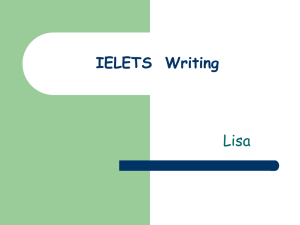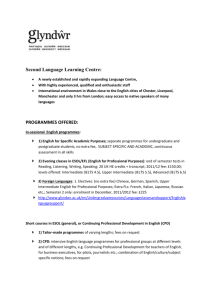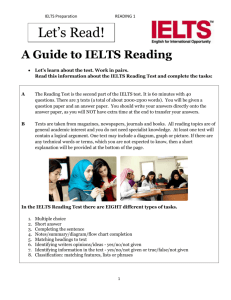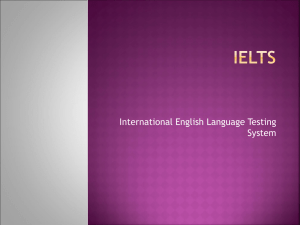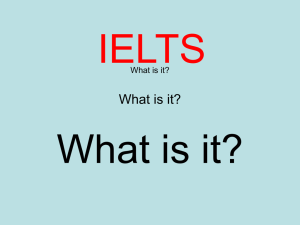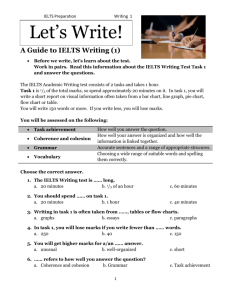File - IELTS Test Preparation
advertisement
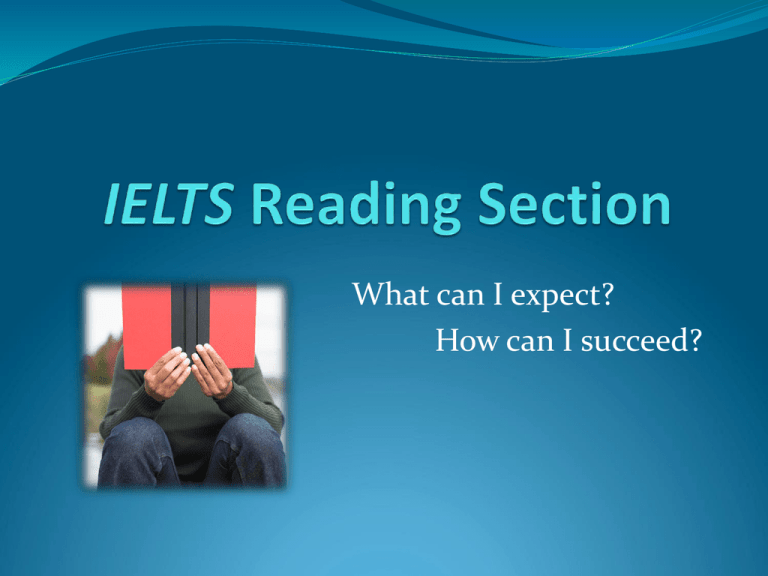
What can I expect? How can I succeed? IELTS Exam Listening 30 minutes, 4 sections, 40 items (+ 10 minutes transfer time) Academic Reading General Training Reading 60 minutes, 3 sections, 40 items 60 minutes, 3 sections, 40 items Academic Writing General Training Writing 60 minutes, 2 tasks (150 & 250 words) 60 minutes, 2 tasks Speaking 11 - 14 minutes, 3 parts Total Test Time= About 2 hours, 54 minutes (including the 10 minute listening transfer time) IELTS Reading Module 60 minutes 40 questions 3 reading passages 2150 – 2750 words total Progressively becomes more difficult Authentic readings from books (A, G), newspapers (A, G), magazines (A, G), journals (A), advertisements (G), notices (G), company handbooks (G) and official documents (G) General vs. Academic One longer text, which is At least 1 passage will descriptive rather than argumentative Type of material needed on a daily basis in an English speaking country Topics are relevant to everyday life in an Englishspeaking country contain a detailed, logical argument Texts are appropriate to candidates entering undergraduate or postgraduate courses Topics are on academic topics of general interest (Ex: The coral reefs, drug addiction) Short factual texts related to a topic, such as hotel advertisements and workrelated issues Skills Assessed A wide range of reading skills is assessed, including: reading for gist, reading for main ideas, reading for detail; understanding inferences and implied meaning; recognising a writer’s opinions, attitudes and purpose; and following the development of an argument.* * From ielts.org Multiple-choice questions Completion of sentences, notes, summaries, tables, diagrams or flow charts Matching headings to paragraphs or sections of the passage Locating information in a paragraph or section Matching lists/phrases True/False/Not Given: identifying information in the passage Yes/No/Not Given: identifying the writer’s view or opinion Question Types Short answer questions Short Answer Questions Questions 8 – 10 Answer the questions below using NO MORE THAN THREE WORDS AND/OR A NUMBER for each answer. 8. Which American company is doing research on the genetic basis of hair and eye colour? 9. How many groups of eye colour can now be identified through SNP mapping? 10. Which British institution unsuccessfully researched data from humans on the genetic basis of facial features? *From Focus on Academic Skills for IELTS book Multiple-Choice Questions *From www.ielts.org Completion Questions Completion of sentences, notes, summaries, tables, diagrams or flow charts The words you use to answer the question must be taken directly from the text; DO NOT paraphrase the answer or put it in your own words or you will not get the answer correct Table Completion Example *From www.ielts.org Completion Questions Diagram Label Completion Example *From www.ielts.org Matching Headings Questions Matching headings to paragraphs or sections of the passage *From www.ielts.org Locating Info Questions *From www.ielts.org Matching Lists/Phrases *From www.ielts.org True/False/NG Questions Questions 1 – 4 Do the following statements agree with the information given in Text 1? Write TRUE if the statement agrees with the information FALSE if the statement contradicts the information NOT GIVEN if there is no information on this 1. Just over one third of the total population of the US is overweight. 2. Asia and Europe have an equal proportion of obese children. 3. It is forecast that the proportion of overweight or obese children in China will reach 20% in ten years’ time. 4. There is a downward trend in childhood obesity in some African towns and cities. *From Focus on Academic Skills for IELTS book Yes/No/Not Given Questions *From www.ielts.org Scoring Each correct answer receives 1 mark (You can’t get partial credit so watch your spelling and grammar) From 2006 Tips – Before Taking the Test Build your vocabulary and synonym word bank Keep a notebook of unknown words and make vocabulary cards Practice skimming and scanning Improve your spelling and grammar Misspelled words will be marked incorrect Grammar knowledge is important Helps you guess the type of word for sentence completion tasks (ex: n, v, adj, plural n) Know word forms (n – v- adj/ Ex: impression – impress – impressionable) Tips – Before Taking the Test Learn organizing words (for matching tasks) such as: advantage, aim, analysis, benefit, consequence, difference, difficulty, discrepancy, effect, factor, feature, goal, hazard, influence, objective, outcome, outline, problem, purpose, reason, risk, role, strategy Understand qualifying words (often for multiple choice questions) such as: mainly, usually, the majority, the most Tips – Before Taking the Test Know prefixes (un-, pre-) and suffixes (-ful, -less) Read from a variety of sources Do practice tests Practice analyzing questions Work on understanding meaning to increase your speed When you’ve become more comfortable with the reading test, give yourself timed practice Tips – During the Test Read the directions 2. Look at the title and headings of the passage to get an idea of what it’s about 1. You can also read the 1st sentence of the 1st paragraph 3. Look at the questions Underline or circle key words in the question Think of possible answers 4. Scan the passage for key words and synonyms Tips – During the Test (cont.) 5. When you find the paragraph/area where the word is, circle or underline the word and skim that area Is this the correct area? Can you find the answer here? If not, then you need to search the text again. 6. If you have more than 1 answer, mark the possible answers on your test booklet (not answer sheet) and then go back after completing that section Tips – During the Test (cont.) 7. For matching headings questions: Skim the headings Find key words or organizing words like problem, effects, reason, etc. and circle or underline them Scan the text for key words or organizing words Think of the logical order 8. Predict which paragraph each heading relates to 9. Quickly read the paragraphs If you have 2 possibilities, write the letters next to it and go back to it after you have matched all headings Tips – During the Test (cont.) Keep in mind, sometimes the questions follow the order of information When you answer the questions, don't spend too much time on the ones you don't feel sure about. Make a guess and go on. Remember that you’re not reading the texts for enjoyment; you need to quickly find the answer Tips – During the Test (cont.) After you have answered all the questions, you can go back and check the ones you aren't sure about (if you have time left) Write your answers directly onto your answer sheet • Don't spend more than 20 minutes on each passage You have about 1 ½ minutes to answer each question
